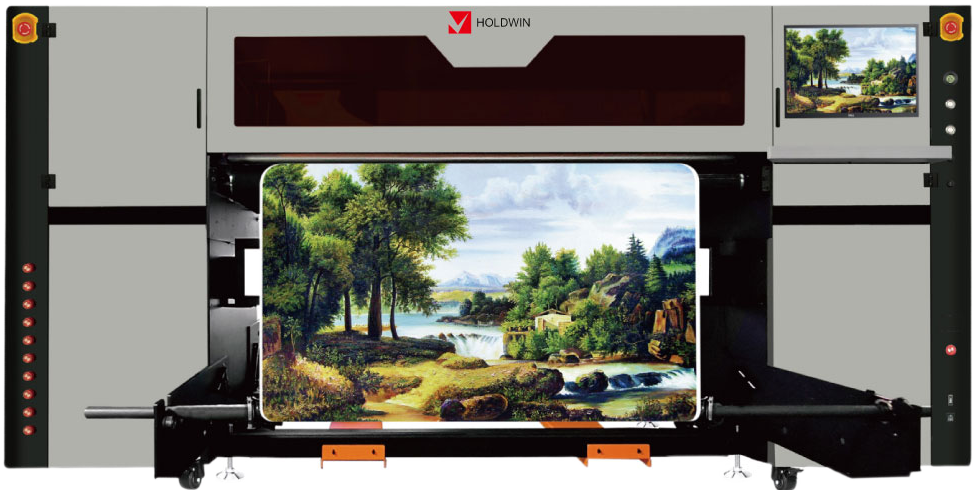
As the textile industry becomes more focused on sustainable practices, digital printing technology has emerged as a valuable tool for reducing the environmental impact of textile production. Digital printing, known for its precision and flexibility, enables companies to lower water and chemical usage, decrease waste, and minimize energy consumption, setting a clear path toward sustainable development. This article explores sustainable practices and innovations within digital textile printing, providing insight into how the industry can adopt greener methods. At HOLDWIN, we are committed to pioneering these changes, aligning our brand vision with global sustainability goals and offering innovative solutions that meet customer demands for eco-friendly, high-quality printing.
Traditional textile printing methods, such as screen printing, are resource-intensive, generating significant waste and requiring large amounts of water, dyes, and chemicals. According to recent studies, the textile industry is responsible for about 20% of global wastewater, a byproduct of dyeing and finishing processes (Smith et al., 2022). Moreover, these processes rely on volatile organic compounds (VOCs) that contribute to air pollution and pose health risks for workers. Digital textile printing offers a promising alternative, minimizing many of these environmental concerns by using on-demand printing techniques, precision ink application, and less water.
Advances in digital textile printing are enabling more sustainable practices through technologies like sublimation printing, DTF (Direct to Film), and UV printing. Each technology provides unique benefits to reduce waste and improve efficiency:
1. Sublimation Printing – Sublimation uses water-based dyes that are eco-friendlier and create vibrant, durable prints with minimal waste, ideal for synthetic fabrics.
2. DTF Printing – Direct-to-film printing offers flexibility and reduces excess materials by applying prints directly to a film for transfer, ideal for custom designs with precise ink usage.
3.UV Printing – UV-curable inks used in UV printing eliminate the need for heat curing, saving energy. Additionally, UV printers can print on diverse materials, expanding sustainable applications in the textile sector.
Sustainability in textile printing goes beyond just technology—it extends to the inks and materials used. Water-based and bio-based inks are increasingly popular, offering lower toxicity and biodegradability. HOLDWIN’s commitment to sustainability includes developing eco-friendly ink options that perform without compromising quality. Furthermore, the choice of textile substrates also plays a role; recycled and organic fibers are becoming more common in sustainable textile printing, providing eco-conscious brands with responsible options.
A recent study highlighted the potential of organic cotton and recycled polyester, which are far less resource-intensive compared to conventional materials (Jones & Alvarez, 2021). By choosing sustainable textiles and inks, companies can significantly reduce their environmental footprint.
Digital printing enables on-demand production—only printing what is needed, when it is needed. This capability is particularly impactful in industries like fashion, where waste reduction is a top priority. On-demand production aligns with the growing trend toward customization and personalization, as customers can order small batches of highly customized designs without the risk of overproduction. At HOLDWIN, our advanced digital printing machines are designed to meet this demand, allowing manufacturers to print precisely what they need, effectively reducing waste.

Energy efficiency is critical for sustainable production, and digital textile printers are increasingly designed with features that reduce power consumption. HOLDWIN’s machines are engineered to use lower temperatures and faster processing speeds, ensuring energy-efficient operations. Furthermore, recent developments in energy recovery systems for large-scale digital printers help capture and reuse energy, cutting down on overall energy requirements. These systems align with HOLDWIN’s goal to create machines that support low-carbon operations, helping textile manufacturers reduce their environmental footprint.
HOLDWIN is dedicated to becoming a world-renowned brand by championing sustainability in digital textile printing. Our product development emphasizes innovation and adaptability, enabling us to provide clients with state-of-the-art machines that support environmentally friendly practices. By continuously refining our technology, we aim to support manufacturers in transitioning to sustainable models that reduce resource consumption and limit environmental impact.
“After switching to HOLDWIN’s digital printing solutions, we saw a dramatic decrease in both waste and water usage in our facility. Our clients love the high-quality, eco-friendly prints, and our commitment to sustainable practices has become a major selling point for our brand.”
The textile printing industry has a unique opportunity to lead in sustainable development, and digital printing is at the forefront of this transformation. From on-demand production to eco-friendly materials and energy-efficient processes, digital textile printing offers diverse pathways to reduce environmental impact. HOLDWIN is committed to supporting this green revolution by providing cutting-edge digital printers that empower businesses to achieve their sustainability goals without compromising quality or creativity. Together, we can pave the way for a greener, more sustainable textile industry.
– Jones, L., & Alvarez, M. (2021). Sustainable textile practices and their environmental impact. Journal of Environmental Management, 287, 112938.
– Smith, R., Wang, Y., & Chen, Z. (2022). The water footprint of textile production and the role of digital printing in reducing water usage. Water Science and Technology, 84(2), 456-465.
– Davis, A., & Lee, J. (2023). Bio-based inks and their potential for sustainable textile printing. Textile Chemistry and Ecology, 45(4), 301-315.

Zhiyu is passionate about good products, good services, and good prices to let consumers know that choosing us is the right choice! For partners and end customers, we will provide one-on-one considerate smart services and provide you with more high-quality procurement solutions.